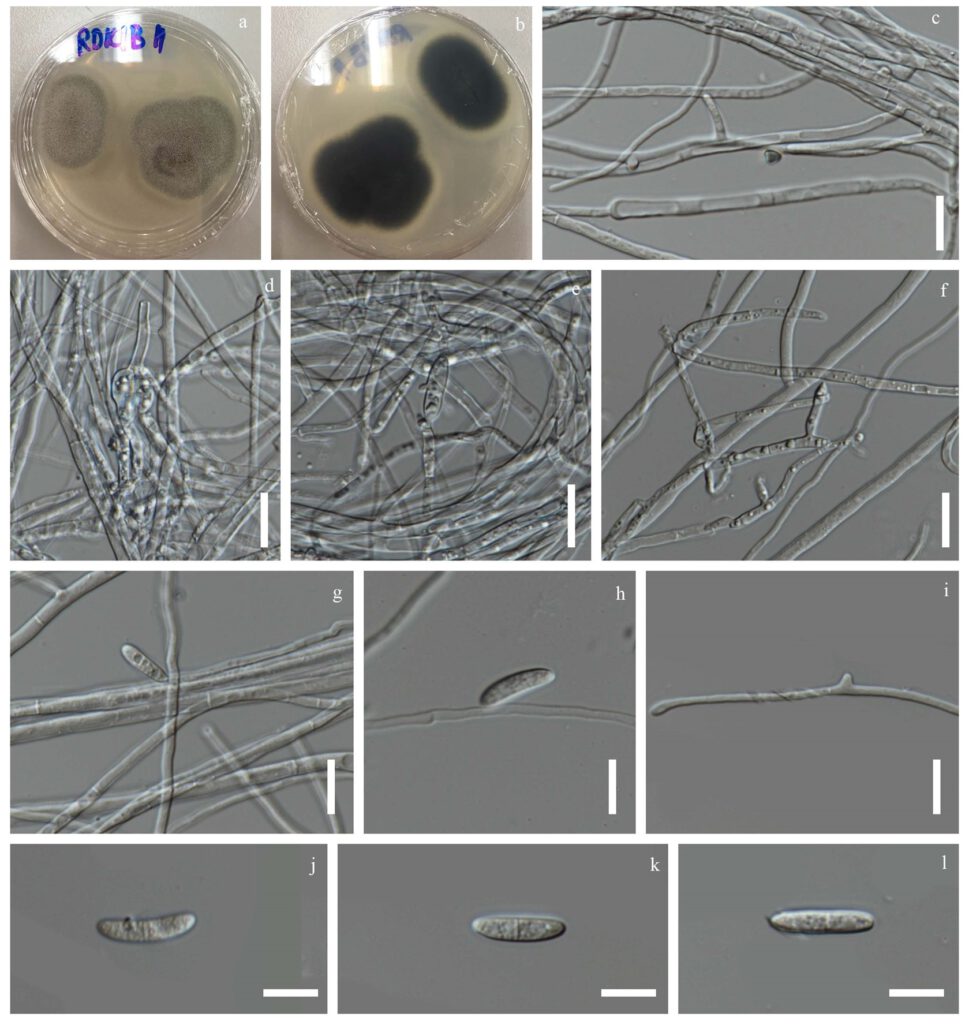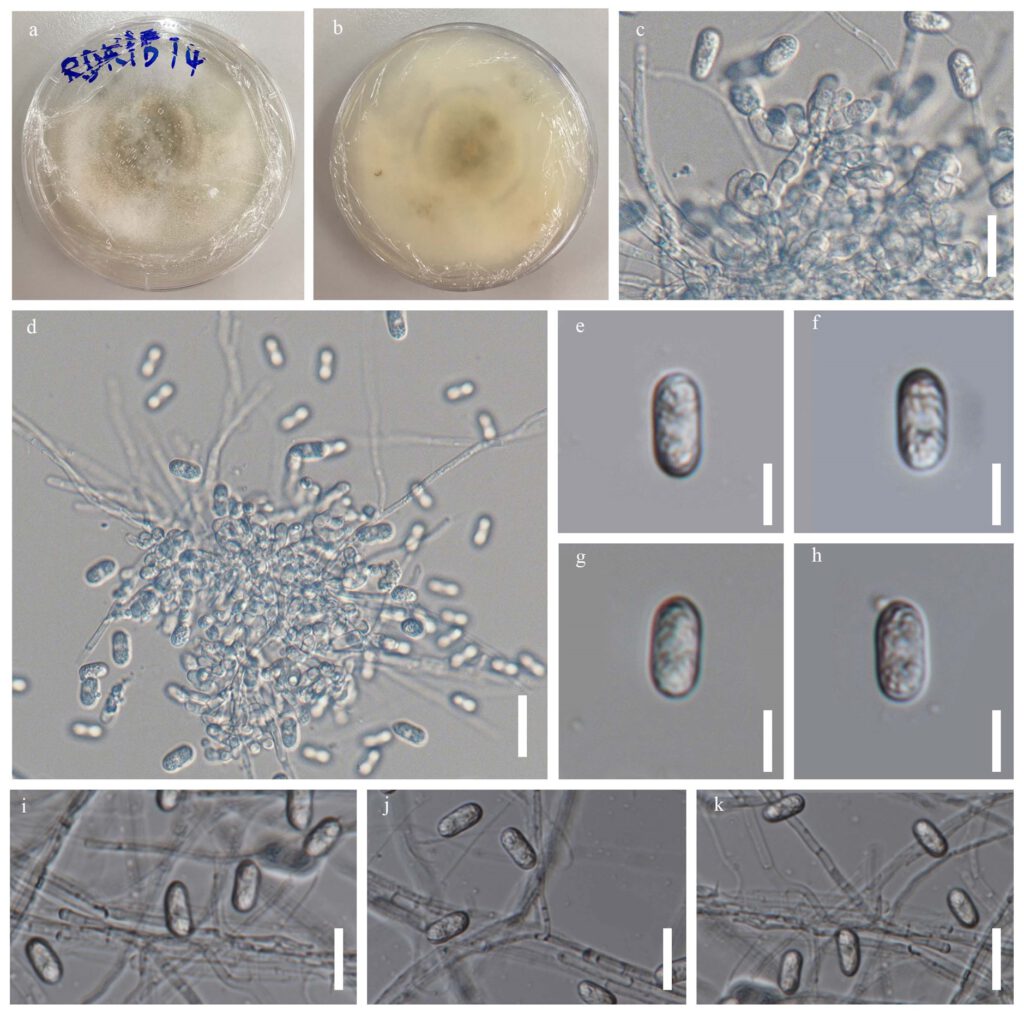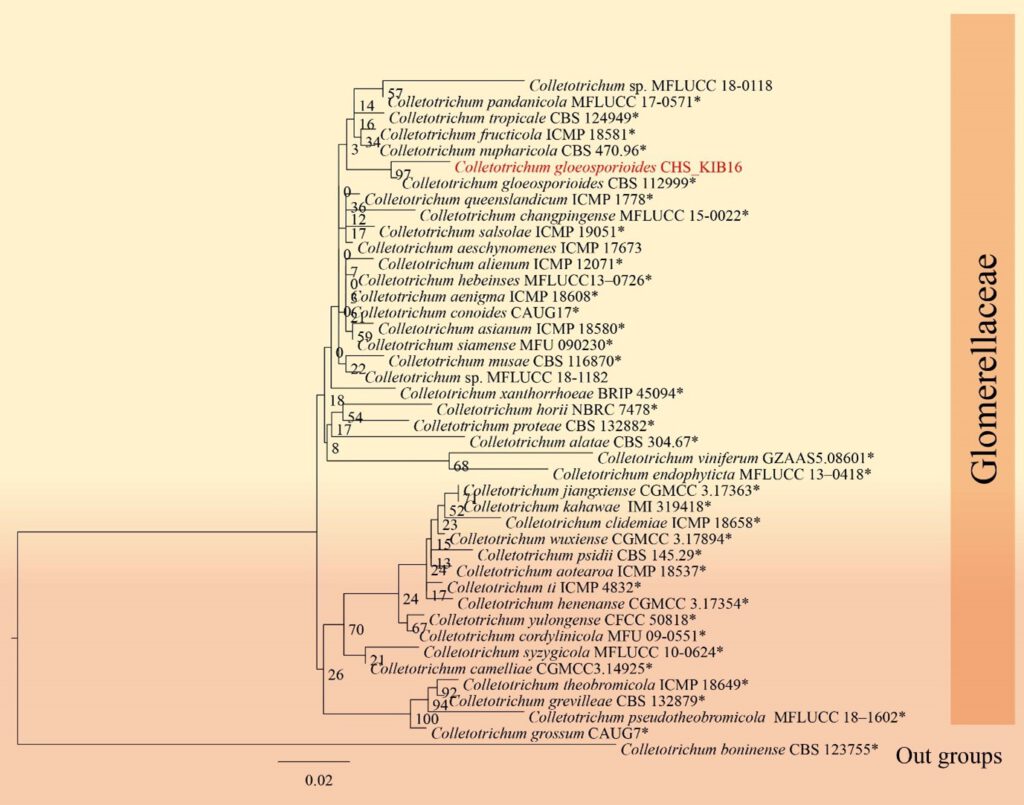Colletotrichum karsti You L. Yang, Zuo Y. Liu, K.D. Hyde & L. Cai [as ‘karstii’], in Yang, Cai, Yu, Liu & Hyde, Cryptog. Mycol. 32(3): 241 (2011), (KIB11) (Ruvi)
MycoBank number: MB 581687; Index Fungorum number: IF 581687; Facesoffungi number: FoF 09442, Fig. **.
Saprobic on dead stems of Rhododendron sp. Sexual morph: Undetermined. Asexual morph: Vegetative hyphae 1–5 μm diam, hyaline, smooth-walled, septate, branched. Chlamydospores single, aseptate, smooth-walled, hyaline, globose, obovoid, 16–25×5–14 μm. Conidiomata absent, the conidiophores formed directly from vegetative hyphae, opening by irregular rupture, the wall composed of textura intricata, covered with brown, verrucose to warted hairs/hyphae, 3–3.5 μm wide, conidiophores lining the inner wall. Setae not observed. Conidiophores hyaline to pale brown, smooth, septate, strongly branched, to 100 μm long. Conidiogenous cells hyaline or pale brown, smooth, cylindrical to elongate-ampulliform, sometimes extending to form new conidiogenous loci, 9–20 × 3–5 μm, opening 1–1.5 μm diam, collarette < 0.5 μm diam, periclinal thickening conspicuous. Conidia hyaline, smooth-walled, aseptate, straight, cylindrical, the apex and base rounded, with a prominent hilum ca. 1 μm diam, < 0.3 μm long, the contents appearing granular, (11.5–)12.5–14(–14.5) × (5–)5.5–6(–6.5) μm. Appressoria not observed.
Material examined – China, Yunnan Province, Kunming district, on dead leaves of Rhododendron sp., 3 February 2019, Napalai Chaiwan, KIB11 (MFLUCC***, living culture), KIB14 (MFLUCC***, living culture).
Host – Diospyros australis, Leucospermum sp., Musa sp. (Damm et al. 2012), Rhododendron sp.—(This study).
Distribution – Australia, Mexico (Damm et al. 2012), China—(This study).
GenBank accession numbers – MFLU **; LSU: ***; ITS: waiting sequence; TUB2: waiting sequence
Notes – Based on phylogenetic tree our isolates in this study group with C. karstii. Colletotrichum karstii belong to the C. boninense complex. It was recently described from a many host plants such as leaf of Vanda sp. (Orchidaceae) in China and several other orchids (Yang et al. 2011). C. karstii is a strain recorded from Passiflora edulis in Brazil that caused anthracnose on passion fruits (Tozze et al. 2010), from Musa acuminata from Thailand (Photita et al. 2005), from Persea americana from Mexico (Silva-Rojas & Ávila-Quezada 2011), Maytenus ilicifolia from Brazil (Pileggi et al. 2009) and Passiflora sp. in Florida, U.S.A. (Tarnowski & Ploetz 2010) but our isolation isolated from Rhododendron sp. Thus, our strain is introduced as a new host record of C. karstii.

Figure***– Colletotrichum karsti (MFLU **** KIB11). a, b Culture on PDA. c, f, i Mycelium. d Chlamydospores. e Conidiogenous cells. g Conidiophore. h, j–l Conidia. Scale bars: c-i = 10 , j-l = 5 μm.

Figure***– Colletotrichum karsti (MFLU **** KIB14). a, b Fruiting body on dead leaf of Dracaena sp. c–i Conidiophore. j–k Conidiogenous cells l–p Conidia. Scale bars: a = 500 , b = 200 μm, c–i = 20 μm, j–k = 10 μm, l–p = 5 μm.

Figure**– Phylogram generated from RAxML analysis based on CHS and ACT sequence data of selected Glomerellaceae isolates. Related sequences were obtained from GenBank. Twenty-four taxa are included in the analyses, which comprise 561 characters including gaps. The tree is rooted to Colletotrichum boninense. The best scoring RAxML tree with a final likelihood value of − 2435.584534 is presented. The matrix had 208 distinct alignment patterns, with 13.92% of undetermined characters or gaps. Estimated base frequencies were as follows; A = 0.221713, C = 0.291673, G = 0.261598, T = 0.225016; substitution rates AC = 0.738134, AG = 2.542407, AT = 1.105215, CG = 0.616134, CT = 4.453137, GT = 1.000000; gamma distribution shape parameter α = 1.243027. Maximum likelihood bootstrap support values ≥ 75% (BT) are given at the nodes as ML. The scale bar indicates 0.02 changes. The isolates obtained in this study are in red and extypes taxa are in black bold.
